The Scented Trash Bags Market is estimated to be valued at USD 1.9 billion in 2025 and is projected to reach USD 2.7 billion by 2035, registering a compound annual growth rate (CAGR) of 3.5% over the forecast period.
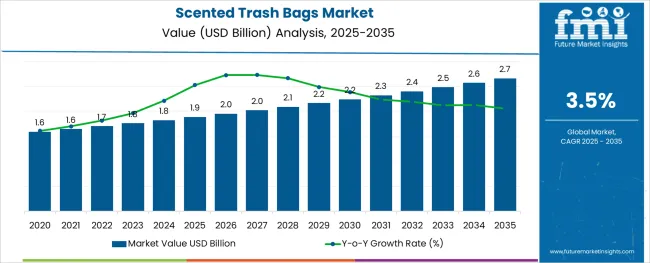
The scented trash bags market has experienced steady growth driven by rising consumer awareness regarding odor control in household and commercial waste management. Increasing urbanization, heightened hygiene standards, and a growing preference for value-added convenience products have collectively contributed to the market’s expansion.
The ability of scented trash bags to effectively neutralize unpleasant odors while providing essential waste containment solutions has positioned them as a preferred choice across residential, commercial, and institutional settings. In recent years, brands have diversified product lines with eco-friendly materials, biodegradable options, and varied fragrance profiles to cater to environmentally conscious and health-aware consumers.
The growing availability of these products through organized retail, e-commerce platforms, and wholesale distributors has further fueled market accessibility and consumer adoption. Looking ahead, continued product innovation focused on natural fragrances, antimicrobial features, and sustainable material sourcing is anticipated to strengthen market growth. The ongoing shift toward premium, specialty packaging in waste management products is expected to reinforce the market’s appeal and ensure a positive growth trajectory over the forecast period.
The market is segmented by Material Type, Capacity, and End User and region. By Material Type, the market is divided into Polyethylene (PE), Polypropylene (PP), and Bioplastics. In terms of Capacity, the market is classified into Upto 10 gallons, 11-25 gallons, 26-55 gallons, and Above 55 gallons. Based on End User, the market is segmented into Retail & Consumer, Institutional, and Industrial. Regionally, the market is classified into North America, Latin America, Western Europe, Eastern Europe, Balkan & Baltic Countries, Russia & Belarus, Central Asia, East Asia, South Asia & Pacific, and the Middle East & Africa.
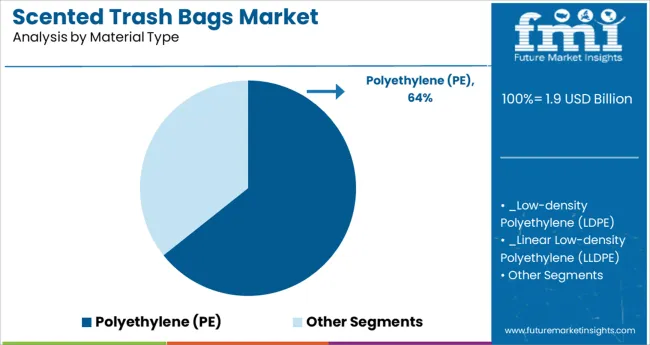
Within the material type category, polyethylene (PE) accounted for approximately 64.3% of the total scented trash bags market share, reaffirming its position as the most widely utilized material due to its durability, flexibility, and cost-effectiveness. PE’s inherent resistance to moisture and punctures has made it a preferred choice for both residential and commercial waste disposal applications.
The material’s compatibility with various fragrances and odor-neutralizing additives has enabled manufacturers to develop a wide range of scented variants that appeal to diverse consumer preferences. Additionally, the ease of customization in terms of color, thickness, and capacity has allowed PE-based scented trash bags to dominate retail shelves and institutional supply chains alike.
The segment’s growth has also been supported by ongoing improvements in film technology and recycling practices aimed at reducing the environmental footprint of PE products. Future expansion is anticipated as brands introduce biodegradable and partially recycled PE variants to address sustainability concerns without compromising performance or consumer convenience.
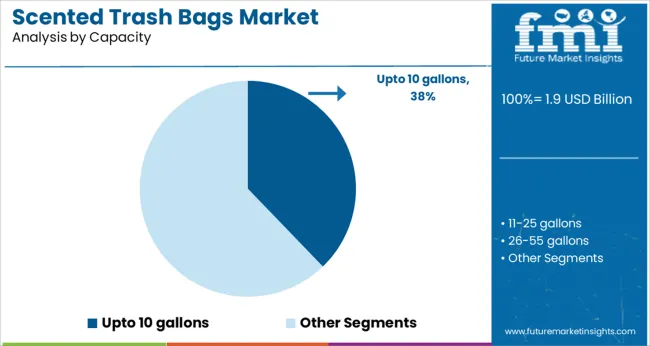
The upto 10 gallons segment led the market by securing a 37.8% share within the capacity category, reflecting strong demand for small-sized, scented trash bags primarily used in households, offices, and personal spaces. This segment’s prominence is attributed to the widespread use of compact waste containers in kitchens, bathrooms, and workspaces where odor control is a priority.
Consumer preference for manageable, lightweight, and disposable waste solutions has further amplified demand for this capacity range. Manufacturers have strategically expanded their offerings with multi-pack options, varied fragrance profiles, and attractive packaging to strengthen product visibility in retail aisles and online marketplaces.
The segment’s resilience is supported by consistent consumption patterns driven by daily household waste disposal needs. Looking forward, increased consumer emphasis on hygiene and air quality within confined living and working environments is expected to sustain the growth momentum of the upto 10 gallons segment, while premium variants featuring natural and allergen-free scents are projected to attract health-focused buyers.
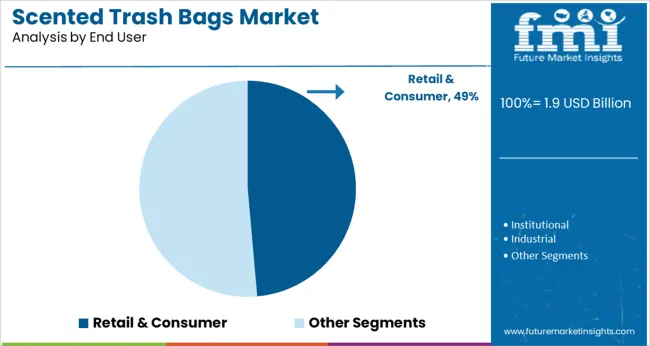
The retail & consumer segment dominated the scented trash bags market by capturing 48.6% of the total end user share, underlining its central role in driving overall market consumption. This segment’s leadership stems from rising consumer inclination toward packaged, fragranced household essentials that offer both functional utility and enhanced living experiences.
The proliferation of organized retail channels, supermarkets, hypermarkets, and e-commerce platforms has significantly increased product accessibility, allowing consumers to conveniently purchase scented trash bags alongside routine household supplies. Continuous marketing efforts promoting the benefits of odor elimination, hygiene maintenance, and aesthetic appeal have reinforced product awareness within this segment.
Additionally, the trend of offering value packs, multi-fragrance assortments, and eco-conscious packaging options has expanded the consumer base, particularly among urban dwellers and young families. Anticipated growth in this segment will likely be driven by premiumization trends, brand collaborations with homecare product lines, and the growing adoption of fragranced waste solutions in small offices and personal care environments.
FMI’s research scope includes scented trash bags for retail & consumer, institutional, and industrial end-users. Demand for scented trash bags is projected to increase at a 3.5% CAGR, in comparison to the 3.2% CAGR registered between 2020 to 2024, wherein sales grew almost 1.2x.
Scented trash bags also known as aromatic/perfumed garbage bags or perfumed trash bags have either a scented additive in the resin, baking soda derives dusted on the surface, or fragrance is added between layers to make the disposal process easier for customers.
These trash bags solve the problem of waste disposal and increase concern about the diseases spread through the garbage, which is expected to create growth opportunities for growth in the forthcoming years.
The growing need for proper disposal of solid and other waste is projected to augment the sales of scented trash bags. According to the World Bank, the municipal solid waste generated annually by the world is around 2.01 billion tonnes.
This is projected to propel the market demand for scented trash bags. The market for scented trash bags is expected to reach a valuation of USD 2.3 Billion by the end of the forecast period.
Self-changing, self-sealing, and automatic garbage disposal are some of the benefits offered by smart trash cans. One of the first smart bins is designed by Knectek Labs Inc. as TOWNEW which is touchless and could be operated with just a wave of a hand.
Scented trash bags could be used in these bins to make the garbage disposal experience better for customers. Hence, automation in the process of garbage disposal is expected to drive the scented trash bags market.
Demand for premium scented trash bags in urban neighborhoods in North America and Europe is increasing as customers are willing to pay extra prices for premium quality scented and sustainable trash bags.
These bags are made with a proprietary material that prevents punctures and leakages which is preferred by customers. According to an industry expert, scented trash bag manufacturers such as Berry Global and Clorox have been devoting a decent portion of their research & development budget to premium scented trash bag technology.
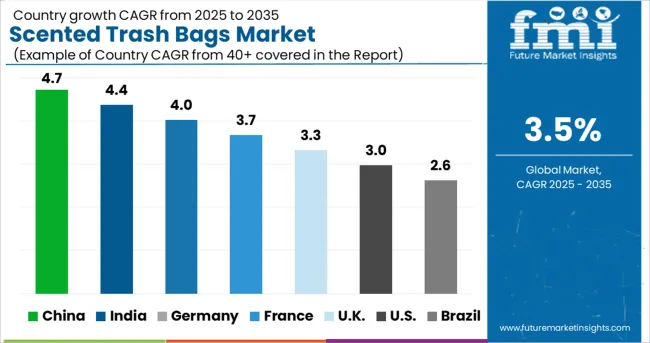
Consumers in the USA. are Preferring Premium Scented Trash Bags
The USA is anticipated to hold a dominant share of North America's scented trash bags market over the assessment period, creating an incremental opportunity of USD 101.5 Million. The growing need for hygienic disposal of waste is likely to propel the demand for scented trash bags in the USA.
Increasing Demand for Bioplastic Scented Trash Bags in Germany Will Fuel Growth
Sales of scented trash bags in Germany are projected to expand 1.3x, growing at a CAGR of 2.9% between 2025 and 2035. According to European Union, the municipal waste recycling rate in Germany was expected to be 68% in 2020, and it is expected to be improved by 1.2x by 2024. European countries, especially Germany have a very systematic waste disposal system.
Germany uses colored bins for waste dumping with waste segregated in colored bags for easy identification. Compostable scented trash bags in Germany presently have a very niche customer segment, however, demand for scented trash bags is expected to gain momentum over the forecast period.
Manufacturers are Preferring Polyethylene for the Production of Scented Trash Bags
In terms of material, polyethylene is the most preferred material for scented trash bags among manufacturers as it provides good tear-resistance and strength. The segment is projected to hold around 69% of the market share by the end of 2035 and is estimated to create the highest revenue opportunities of USD 2.7 Million by 2035. However, the ongoing sustainability trend and environmental regulations such as a single-use ban on plastics in several countries are likely to propel sales of bioplastics material during the forecast period.
Sales of Scented Trash Bags in the Retail & Consumer Segments Remain High
Based on end users, the retail & consumer segment is projected to hold approximately 51% of the global scented trash bags market by 2035, expanding by 1.4x of the current market value. Scented trash bags are commonly used for the storage and disposal of waste as it helps reduce the odor of the garbage. Moreover, rising awareness of hygiene and cleanliness among consumers is anticipated to boost demand for scented trash bags over the forecast period.
Consumers are Preferring Up To 10 Gallons Capacity in Scented Trash Bags
By capacity, scented trash bags of up to 10 gallons are the most popular bags in the market. The 10 gallons capacity is used as bin liners and trash bags on a daily basis in households and offices.
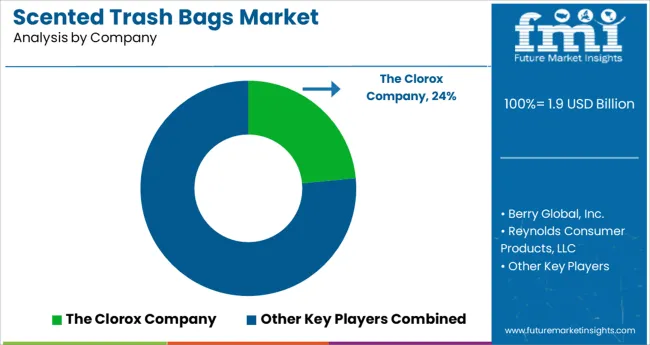
The scented trash bags market is a comparatively less fragmented market and most of its customer base comes from North America and Europe. Scented trash bag manufacturers are focusing on the introduction of more recyclable and sustainable products. For instance:
| Attribute | Details |
|---|---|
| Forecast Period | 2025 to 2035 |
| Historical Data Available for | 2020 to 2024 |
| Market Analysis | billion for Value and Million Units (Million Units) for Volume |
| Key Regions Covered | North America; Latin America; Europe; Middle East & Africa; East Asia; South Asia; and Oceania |
| Key Countries Covered | The USA, Canada, Brazil, Mexico, Germany, France, Italy, UK, Spain, Russia, China, Japan, India, GCC Countries, Australia |
| Key Segments Covered | Material Type, Capacity, End User, and Region |
| Key Companies Profiled | The Clorox Company; Berry Global, Inc.; Reynolds Consumer Products, LLC; Napco National; Simplehuman, LLC; Yantai Bagease Packaging Products Co., Ltd.; AbbeyPolythene Ltd.; Sakthi Poly Products; Shenzhen Juyi FII Co., Ltd.; Easy Flux Polymers Pvt. Ltd. |
| Report Coverage | Market Forecast, Company Share Analysis, Competition Intelligence, Drivers, Restraints, Opportunities and Threats Analysis, Market Dynamics and Challenges, and Strategic Growth Initiatives |
The global scented trash bags market is estimated to be valued at USD 1.9 billion in 2025.
It is projected to reach USD 2.7 billion by 2035.
The market is expected to grow at a 3.5% CAGR between 2025 and 2035.
The key product types are polyethylene (pe), _low-density polyethylene (ldpe), _linear low-density polyethylene (lldpe), _high-density polyethylene (hdpe), polypropylene (pp) and bioplastics.
upto 10 gallons segment is expected to dominate with a 37.8% industry share in 2025.






Full Research Suite comprises of:
Market outlook & trends analysis
Interviews & case studies
Strategic recommendations
Vendor profiles & capabilities analysis
5-year forecasts
8 regions and 60+ country-level data splits
Market segment data splits
12 months of continuous data updates
DELIVERED AS:
PDF EXCEL ONLINE
Competitive Overview of Scented Trash Bags Companies
Scented Insert Applicators Market Analysis - Size and Share Forecast Outlook 2025 to 2035
A Detailed Global Analysis of Brand Share for the Scented Candle Market
Scented Candlе Industry Outlook
Scented Paper Market Trends – Growth & Forecast 2024-2034
Market Share Insights of Unscented Moisturizer Providers
Unscented Moisturiser Market Growth – Trends & Forecast 2024-2034
United States Scented Garbage Bags Market Size and Share Forecast Outlook 2025 to 2035
Trash Rack Cleaning Machine Market Size and Share Forecast Outlook 2025 to 2035
Trash Bag Market Size and Share Forecast Outlook 2025 to 2035
Trash Bag Industry Analysis in Europe Forecast Outlook 2025 to 2035
Trash Bag Market Leaders & Competitive Insights
Türkiye Trash Bag Market Trends & Growth Forecast 2024-2034
Trash Can Liner Market Growth – Trends & Forecast through 2034
Trash Can Market
Polybags Market Size and Share Forecast Outlook 2025 to 2035
Net Bags Market
VCI Bags Market
Sandbags Market
Leno Bags Market Size and Share Forecast Outlook 2025 to 2035

Thank you!
You will receive an email from our Business Development Manager. Please be sure to check your SPAM/JUNK folder too.
Chat With
MaRIA